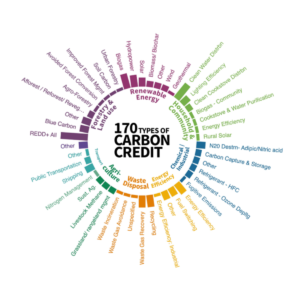Carbon Credit & Offset
Carbon Credit & Offset
What Is A Carbon Credit?
Carbon credit (СС) is an emission permit for a specified amount of carbon dioxide (CO2) or other greenhouse gases (GHGs). For every one credit, you can release into the atmosphere one metric ton (2204 pounds) of CO2 or an equivalent amount of another GHG. A company is eligible to receive credits if it cuts its emissions below a certain threshold. Companies commonly produce carbon removal credits through their efforts and investments that promote reforestation, energy conservation, and renewable energy. There’s also the option of buying CCs from companies that haven’t used them all.


Purpose Of Carbon Credits
CCs are intended to serve as a financial incentive for companies to minimize their greenhouse gas emissions and engage in greener, more sustainable operations in agriculture and other industries. This market-based instrument helps us all fight climate change by supporting programs for reducing or eliminating GHG emissions.
Initiatives To Regulate The Carbon Market
International agreements like the Kyoto Protocol, the Paris Agreement, and the Glasgow Climate Pact have established frameworks for countries to limit greenhouse gas emissions through CC trading systems. The United States was an early adopter of cap-and-trade systems, and since then, numerous state and regional carbon credit programs and efforts have arisen to encourage companies to lessen their impact on the environment. This section will give an overview of these major initiatives aimed at curbing climate change.How Carbon Credits Work
Carbon credits are the mechanism that allows carbon revenue to be transferred from businesses to regulators (typically governments). In most cases, the yearly credit allocation is dictated by the country’s or state’s emission targets.The cap-and-trade model is the most common approach to pricing CO2 emissions. Many countries, including the USA, Canada, Mexico, China, New Zealand, the UK, and the EU, have already adopted this model, and many more are contemplating its adoption.
In cap-and-trade systems, a regulator establishes a cap (the highest authorized level of emissions), and companies trade emission permits according to carbon credit market demand.
It becomes increasingly challenging for companies to maintain their operations under the cap as it is steadily lowered over time. At the same time, a company may earn money by selling excess credits to other companies. So, businesses have a motive to cut down their environmental footprint. At the end of the day, businesses facilitating the reduction of CO2 emissions under a cap-and-trade system would have an easier time meeting emission targets.
Types Of Carbon Credits
Carbon credits are available in two different forms: Certified emission reduction (CER). They are issued and overseen by institutional funds, mostly to offset the environmental impact of certain projects like power stations. Voluntary emission reduction (VER). These carbon credits are traded in voluntary markets free of third-party regulation. The main distinction is that CERs have an official compliance status with the Kyoto Protocol, while VERs are not subject to regulatory caps and oversight.
We develop certified projects that generate Carbon Credits
WSO operates in the voluntary carbon market (VCM), an innovative sector that aims to reduce pollution from carbon dioxide (CO₂) emissions on our planet. From analyzing your company’s carbon footprint to an emissions neutralization strategy, we activate and track projects that certify your commitment to the planet.
From carbon footprint to carbon neutrality
Calculating your company’s carbon footprint means determining the amount of CO₂ it emits into the atmosphere. This is the first step in the entire offsetting process: by purchasing carbon credits, you can finance projects that aim to absorb these emissions, effectively achieving carbon neutrality.
We certify Our projects with the best international standards. From development to monitoring, our projects are entirely managed by us
We generate certified Carbon Credits through CO₂ removal and reduction.
We compensate Companies’ emissions to help them meet their environmental goals We communicate Our clients’ sustainability commitments to their stakeholders



